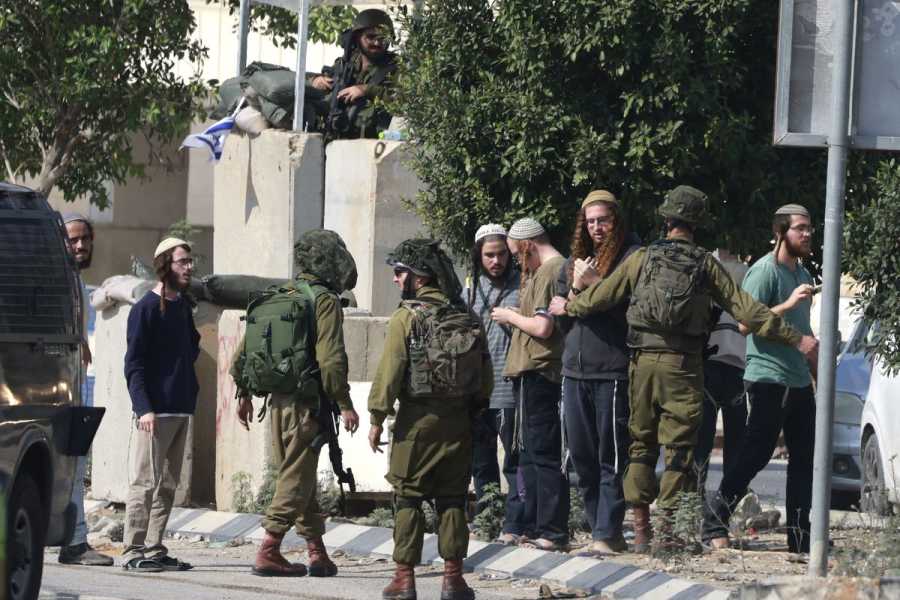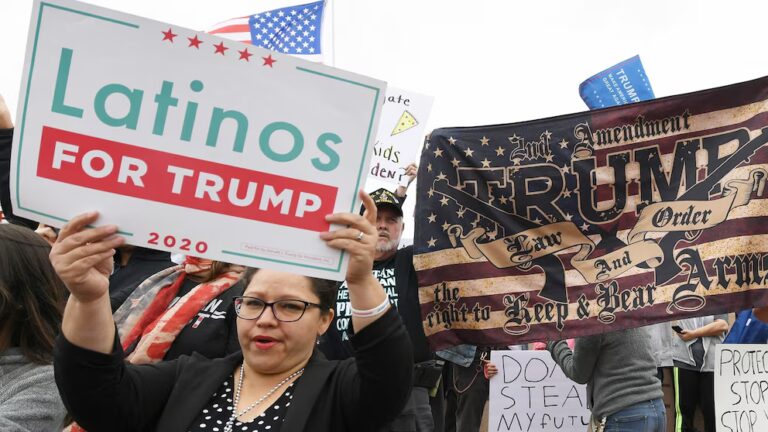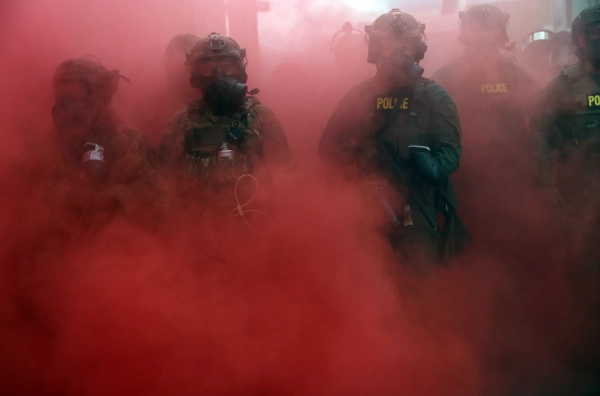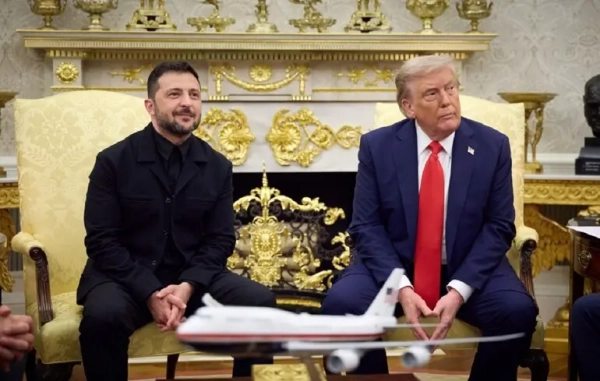With the world focused on Gaza, Israeli settlers and soldiers are increasing attacks on Palestinians in the West Bank.

Israeli soldiers restrain Jewish settlers after they stormed the Palestinian West Bank village of Dayr Sharaf following the death of an Israeli man on November 2, 2023, amid the ongoing battles between Israel and the Palestinian group Hamas in the Gaza Strip. Jaafar Ashtiyeh/AFP via Getty Images
The world’s eyes have been on Gaza since Hamas’s brutal attack on Israeli citizens on October 7 and Israel’s retaliatory invasion that has killed thousands of Palestinian civilians.
But another front in this long-running conflict is the West Bank, a kidney-bean shaped piece of land on the west bank of the Jordan River and to the east of Israel that is home to nearly 3 million Palestinians and would make up the heart of any future Palestinian state. Alongside those Palestinian cities and villages, however, are Jewish settlements.
Since the Six-Day War of June 1967, the state of Israel has planned and funded Jewish outposts throughout the West Bank; other settlers have moved in without the state’s explicit backing. The settlers believe they have a right to be there, even though most of the international community views the settlements as illegal.
These populations are largely separated by Israel’s complex security infrastructure, including military checkpoints, armed patrols, a separation barrier, and color-coded identification cards and license plates. This system dictates all aspects of daily life for West Bank residents.
Some settlers have for years harassed and attacked the Palestinians living there, often with impunity and occasionally with the support of Israeli soldiers. In the weeks since October 7, however, the rate of violence has significantly increased. It is already the deadliest year since the Second Intifada, and is getting bad enough for the eyes of the world to occasionally leave Gaza and look to the West Bank.
“I continue to be alarmed about extremist settlers attacking Palestinians in the West Bank,” President Joe Biden said in late October, comparing the attacks to “pouring gasoline on fire.”
Meanwhile, popular support for Hamas has surged among Palestinians in the West Bank as faith in the Palestinian Authority plummets.
This escalation of settler violence could, as Vox’s Zack Beauchamp explains, “lead to a deeper entrenchment of Israel’s occupation and, quite possibly, a violent Palestinian response that brings outright war to the West Bank.” That would in turn “weaken the already-slim prospects of a negotiated solution to the Israeli-Palestinian conflict in the foreseeable future,” he writes.
The writer Nathan Thrall is well acquainted with the dual lives of Palestinian and Israeli residents of the West Bank. Thrall spent a decade at the International Crisis Group covering Israel, the West Bank, and Gaza. In his new book A Day in the Life of Abed Salama: Anatomy of a Jerusalem Tragedy, he tells the story of a Palestinian father from the West Bank searching for his son who’s gone missing after a school bus accident.
Thrall spoke with Today, Explained host Noel King about the history of Israeli settlements in the West Bank, and why Israel faces strong criticism for its support of settlers, not just from Palestinians but also from some Israelis and the international community. Read on for an excerpt of the conversation that aired on November 20, edited and condensed for length and clarity, and listen to the full conversation wherever you find podcasts.
Help situate us: What does the West Bank look like? And who lives there?
The West Bank is quite hilly. It has a mountain ridge running through the middle of it, north to south. And it is covered with Israeli settlements. These settlements in the popular imagination are a set of caravans haphazardly erected on a hilltop. [Some newer outposts, particularly illegal ones, do consist largely of portable buildings.] But in fact, [many] are towns and cities that look identical to the communities of similar size within Israel proper. And they are connected seamlessly to Israel proper. The residents of these communities include Israel’s elite. They include Supreme Court justices. They include ministers in the Israeli government and many, many other government employees and leaders in industry.
These people are able to live in these communities precisely because they have been segregated from the Palestinian population that surrounds them. They have been given roads that cut through these Palestinian communities without having exits or entrances for the Palestinian communities that these highways pass through. This whole architecture, this infrastructure, gives the Jewish residents of these settlements the illusion that they are living in a Jewish-only zone where they don’t really have to confront or think about the Palestinians who are just beside them, and they can go very easily to their workplaces in Tel Aviv or Jerusalem and believe that they are living in a suburb just like any other.
How long have the Israeli settlements been in the West Bank?
The settlement project began, really, as soon as Israel conquered the West Bank and East Jerusalem. Those settlements were created by the Israeli center left that had been in power since the establishment of the state in 1948 and remained in power until 1977. So for the first decade of the settlement project, it was driven by center-left governments. And it’s important to stress it was driven by the government. This is not a story of a bunch of radicals twisting the arm of the state against its will, which is how it’s often depicted. This is a state-driven project and it is in fact the greatest project, the largest and most expensive project, that the state of Israel has undertaken.
As the settlers have moved in, how have they justified this?
There are a number of different motivations for moving to the settlements. Broadly speaking, there are three groups of settlers.
There are ideologically driven settlers who believe that the West Bank is the historic homeland of the Jewish people and that they have every right to build homes and establish Israeli sovereignty in these areas, no less so than Israel had a right to establish settlements in 78 percent of historic Palestine, the borders of Israel prior to 1967. And this is an argument that they make to their detractors in Israeli politics.
The second type of settler is just an ordinary middle-class or upper middle-class person who is moving there because there are financial incentives to do so. You can have a nicer home, a larger home, a less expensive home. And because it has all been set up in a way that makes it painless to live there and gives you the sense that this is really no different than any other suburb, members of the middle class do move there. What happens over time is they often start to shift ideologically after moving there because every human being naturally wants to feel justified in what they’re doing.
The third type are ultra-Orthodox Jews, and they historically had avoided living in settlements. But that changed. And they live in a few settlements, but they’re very large and dense. And those settlements are, for the most part, closer to the edge of the West Bank, closer to the boundary with pre-1967 Israel.
How do Palestinian and Jewish residents of the West Bank interact with each other? Do they interact with each other, typically?
The Palestinian and Jewish communities in the West Bank are entirely segregated and the settlements have gates at their entrances and security guards at those gates. Palestinians are not allowed to enter them unless they are coming as pre-approved workers, as cleaners or gardeners or construction workers. That’s the degree of segregation that exists in the West Bank. [Israel justifies these measures as necessary for the security of both Jewish and Palestinian populations, but human rights groups like B’Tselem say these tactics are entirely geared toward making Palestinians’ lives unbearable and forcibly driving them off their land.]
So this is a highly unequal situation. If you are Palestinian in the West Bank, you are subject to restrictions. You are subject to inequities. But then on top of that, Nathan, we hear about settler violence. What does this refer to? What does that mean?
So settler violence is a broad term that includes everything from settlers going and burning down olive trees of Palestinians who live nearby. It includes raids on Palestinian communities in the middle of the night. It includes activities that Israeli officials even have referred to as pogroms, such as the burning of all kinds of property in the town of Huwara earlier this year or in the town of Turmus Ayya last June.
The Palestinians who are attacked are entirely defenseless in this situation. [Israel points to terror attacks by Hamas, including a November 30 shooting at a bus stop in west Jerusalem, as a reason to maintain security measures.] They know that if they lay a single finger on an armed settler who enters their home, they can be arrested and put in jail and locked up in what is known as administrative detention, which is detention without trial or charge. Israel can do that for six months to somebody, and then extend it indefinitely.
And so when a Palestinian encounters a settler militia, they know that putting their finger on that settler is not putting their hand on an individual. It’s putting their hand on the entire state of Israel, this enormous machine that controls their every movement and that can arrest them and their family members at any moment.
How is it that the settlers can commit such violence without legal repercussions? Where does the law fit in here?
The law doesn’t fit in here because there is total impunity for the settlers. When there are cases filed against settlers for attacks on Palestinians, fewer than 10 percent result in an indictment and only 3 percent result in a conviction. That’s data from the last 18 years. And now after October 7, when most of the regular army is off in Gaza or on the border with Lebanon, you have those same settlers who were attacking the Palestinian communities several months ago, now in uniform [called up from the reserves], with full authority to do those same attacks as the army.
We know that there will be an end in Gaza. We don’t know what it is. And it sounds as though the Netanyahu government and the international community are actively debating, discussing, what the end in Gaza will look like. But in the West Bank, it seems as though there is no end in mind. How do you envision this playing out? Where do you think this is all leading, Nathan?
No matter how long this war in Gaza lasts, whether it’s weeks or months or years, at the end of it, we are going to be in the situation that we were in on October 6, which is 7 million Palestinians, 7 million Jews, all living under Israeli rule. And the vast majority of those Palestinians don’t have basic civil rights. That’s the situation that the international community and the United States will need to address if they want to see an end to this recurrent bloodshed.
Sourse: vox.com






